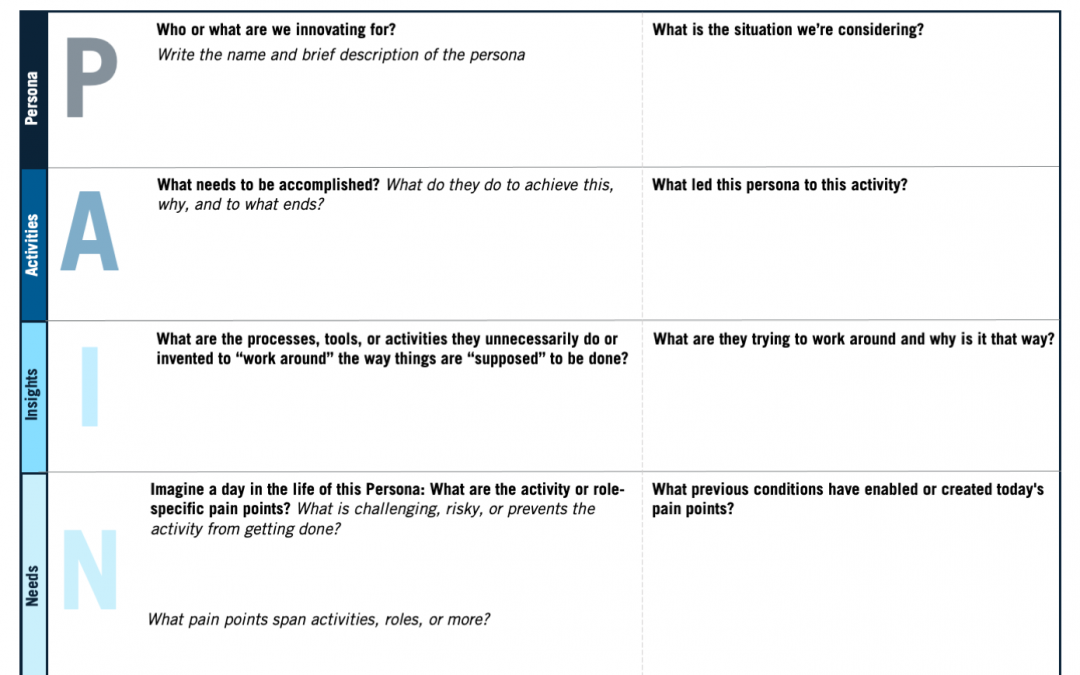As part of Team Toolkit’s collaboration with the MITRE Social Justice Platform, we are excited to announce the equity-lens update to ITK PAINstorming!
ITK PAINstorming helps improve your team’s understanding of a user’s behaviors, pain points, assumptions, and needs. This worksheet helps focus your team on addressing actual user preferences, and it can also help explore assumptions or unknown gaps about users.
The updated ITK PAINstorming worksheet adds new questions to help your team better understand your ideal user. In addition, the embedded equity lens helps your team broaden their perspective to consider what else may have historically occurred or be contributing to today’s current status quo. Collectively exploring these additional questions will help your team develop deeper insights about your ideal user and identify more opportunities for innovation.
PAIN stands for Persona, Activities, Insights, and Needs – the four main research topics explored in this structured method for gathering insights about users or user identities.
The Personas block sets the scope for your team’s discussion by asking who or what you’re innovating for, as well as which situation is being considered.
The Activities block asks about what the user is trying to accomplish. The embedded equity lens takes this further to ask what led this user to this activity. This question encourages your team to explore what may have been occurring not only at an individual level, but at the systemic, institutional, environmental, and possibly intergenerational level.
The Insights block asks about workarounds that the user has invented or employed to help them better achieve what needs to be done. The embedded equity lens broadens your team’s perspective by asking why the workaround was necessary in the first place and how it came to be. In some problem-solving situations, your team may be focused too narrowly on the symptoms that are in front of them rather than seeing the larger, inequity problem that surrounds them. By addressing the true root cause of a problem, more lasting equitable outcomes can be created.
The Needs block asks about the activity and role-specific pain points that the user experiences. The embedded equity lens again broadens your team’s perspective by asking about what previous conditions have enabled or created today’s pain points. Similar to the Activities block, this question encourages your team to consider not just individual impacts, but also systemic, institutional, environmental, and possibly intergenerational impacts.
Lastly, we updated the tool instructions to reduce harmful terms such as “target user.” Since some groups have truly experienced unfair targeting, the use of this term may reinvoke painful memories or perpetuate harm to this group. Instead, we use “ideal user” or simply “user” throughout the instructions.
We hope you find the updated ITK PAINstorming worksheet useful, and let us know what you think in the comments below!
Interested in learning more about other ITK tools with an embedded equity lens?
- Check out the updated Problem Framing canvas and the accompanying ITK blog article which explains the equity lens
- Check out the new Stakeholder Identification canvas and the accompanying ITK blog article which explains the equity lens
- Check out the new Quickstart Stakeholder Engagement canvas and the accompanying ITK blog article which explains the equity lens
- Check out the new Stakeholder Power Categories and the accompanying ITK blog article which explains the equity lens
- Read more about Team Toolkit’s equity-driven efforts here
- Click on the “Equity Driven Design” category on the right to filter relevant blog articles
- Sign up for our listserv to get the latest updates as more tools are released!

